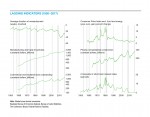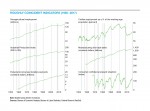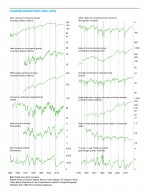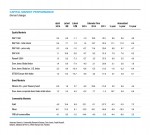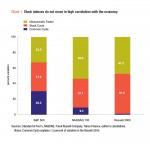January Business Conditions Monthly

AIER’s Business Cycle Conditions Leading Indicators index fell 21 points to 58 in December. The Roughly Coincident Indicators index held at 100 while the Lagging Indicators index gained 16 points to reach 83 (see chart). The sharp decline in the Leading Indicators index is a cautionary sign but index is still above 50, providing some reassurance.
The latest monthly employment report showed broad strength with a significant increase in payroll employment, an increase in the participation rate, and a solid gain in average hourly earnings. A strong labor market is likely to provide a foundation for consumer spending.
Household net worth hit another record high for the third quarter as assets posted a solid gain while debt growth was modest. The personal savings rate held steady for the third quarter while the liability-to-asset ratio for nonfinancial corporations remained close to its 40-year average.
Leading indicators declined for a third month in December
Note: The government shutdown includes the Department of Commerce, the source of some of the AIER business cycle indicators. For the December update, only one indicator has been affected, real private nonresidential construction. The remaining 23 indicators were updated on schedule. Real private nonresidential construction had a neutral reading in November, and that result was maintained in the absence of new data.
The AIER Leading Indicators index fell 21 points to 58 in December. The fall was the largest since February 2014, and the level is the lowest since October 2016. Overall, just 5 of the 12 leading indicators maintained a positive trend in December, with 3 trending lower while 4 indicators were neutral.
Positive trends were maintained by real retail sales and food services, real new orders for consumer goods, real new orders for core capital goods, total heavy-truck unit sales, and the 10-year–1-year Treasury yield spread. Neutral results came from initial claims for unemployment insurance, the ratio of manufacturing and trade sales to inventory, the University of Michigan index of consumer expectations, and real stock prices. All four indicators showed positive trends in November. Housing permits and debit balances in customers’ margin accounts continued in a downtrend in December while the average workweek in manufacturing turned to a downtrend.
Overall, the Leading Indicators index remains above 50, indicating continued expansion is likely. However, the results among the 12 leading indicators were mixed as major categories of indicators (labor, financial, real activity) showed some strength and some weakness. The broad mix of results suggests a moderate degree of caution is warranted.
The roughly coincident indicators held at a reading of 100 in December. The Roughly Coincident Indicators index has oscillated between 92 and 100 since March 2017, hitting 92 in 5 of those months and scoring perfect 100s in 17.
AIER’s Lagging Indicators index improved somewhat in the latest month, returning to a reading of 83 in December from 67 in November. That follows four consecutive months with a reading of 83, from July through October, and three months at 92, from April through June. Duration of unemployment was the one indicator to show improvement in December, turning from a neutral trend to a positive trend.
Among the six lagging indicators, four indicators are trending higher, none are trending lower, and two are neutral. That compares to three trending higher, three trending neutral, and none trending lower in November.
Overall, the three AIER business cycle–indicator indexes are still in favorable territory, suggesting a continued positive economic outlook. However, the significant decline in the Leading Indicators index suggests that some patches of weakness are emerging and that the risk of recession has risen slightly. Vigilance is warranted given the high level of uncertainty regarding trade and fiscal policy as well as the overall interest rate environment.
Labor market remains solid
Hiring rebounded in December as nonfarm payrolls added 312,000 jobs last month, after an increase of 176,000 new jobs in November. The December gain was the largest since February 2018. For the private sector, nonfarm payrolls added 301,000 in December following a gain of 173,000 in November. On a three-month average basis, private payrolls added 252,000, and over the past year the average gain is 214,000.
Goods-producing industries added 74,000 in December, ahead of the monthly average gain of 52,000 over the past year. Durable-goods manufacturing and construction led with additions of 19,000 and 38,000 jobs, respectively, while nondurable-goods industries added 13,000. Within private service-producing industries, which typically account for the lion’s share of job creation, payrolls added 227,000 workers, led by a 58,000 gain in health care and social assistance and a 55,000 jump in the leisure and hospitality industries. Professional and business services posted a gain of 43,000 jobs for the latest month, below the 49,000 average over the past year, while retail added 24,000 jobs in December.
The unemployment rate rose to 3.9 percent from 3.8 percent in November. The labor force participation rate ticked up to 63.1 percent in December as 419,000 people joined the labor force. The participation rate briefly dipped to a cycle low of 62.4 percent in September 2015 but has been essentially trending flat between 62.7 percent and 63.1 percent since late 2013.
Average hourly earnings rose 0.4 percent in December, pushing the 12-month change to 3.2 percent. AHE growth has been very slow compared to previous cycles, especially given the low unemployment rate, but has been accelerating recently. That is good news for employees but could be a problem for employers.
Combining payrolls with hourly earnings and hours worked, the index of aggregate weekly payrolls rose 0.9 percent in December and 5.2 percent from a year ago. This index is a good proxy for take-home pay and has posted relatively steady year-over-year gains in the 3 to 5 percent range since 2010 but has now been above 5 percent for 7 of the last 10 months. Continued gains in the aggregate-payrolls index is a positive sign for consumer income and spending, supporting continued economic expansion.
The solid employment report is somewhat reassuring given the volatility in financial markets, weakness in some economic indicators, and high degree of uncertainty surrounding trade, fiscal, and monetary policy.
Household net worth hits $109 trillion in the third quarter
Household net worth reached $109 trillion at the end of the third quarter. Total assets were $124.9 trillion, with financial assets at $89.8 trillion, or 71.9 percent of the total, while nonfinancial assets were $35.1 trillion, or 28.1 percent. Total assets increased 1.8 percent for the quarter and were up 7.6 percent from a year ago.
Household liabilities were $15.9 trillion at the end of the third quarter. Mortgage debt was $10.3 trillion, or about 64.5 percent of the total. Total household liabilities increased 1.1 percent for the quarter and were up 3.5 percent from a year ago. Mortgage debt rose 0.9 percent for the quarter while the value of household real estate rose 1.2 percent. Total owners’ equity in real estate rose to 59.94 percent of the value of the real estate, the highest since 2002. Consumer credit totaled $3.9 trillion, or about 24.7 percent of total household liabilities after a 1.9 percent increase for the quarter. From a year ago, consumer credit is up 4.5 percent. Total household liabilities were 12.7 percent of total household assets, the lowest ratio since 1985.
Personal savings rate holds steady
The personal savings rate, savings as a percentage of disposable personal income, came in at 12 percent in the third quarter as measured by the flow-of-funds report. This measure is broader than the monthly measure from the Bureau of Economic Analysis that is often quoted.
On a three-year moving-average basis (to dampen quarterly volatility), the personal savings rate was 10.5 percent, down slightly from 10.7 percent in the second quarter. The rate has been bouncing around in the 10 to 12 percent range for most of the past nine years. That is a solid improvement over the 6 to 10 percent range for 1999 to 2008 period but well below the 15 to 18 percent range that prevailed for most of the period from 1965 through 1990.
The measure of personal savings from the Bureau of Economic Analysis shows a rate of 6 percent for the month of November, the latest data available. On a three-year average basis, the rate was 6.7 percent, well below the rate measured in the flow-of-funds report. The difference is due to definition and methodology differences, but the movements in the rates are generally similar. Personal savings rates are higher than in the early 2000s but well below the rates of the mid-1960s through 1990.
Nonfinancial corporate balance sheets look solid
Total liabilities for the nonfinancial corporate sector rose 1.0 percent in the third quarter, exceeding the 0.2 percent gain in total assets. That result pushed the ratio of liabilities to assets to 44.7 percent from 44.4 percent at the end of the second quarter. However, at 44.7 percent, the ratio is right in line with the 40-year average ratio of 44.6 percent and well below the peak of 50.5 percent from 1993 and the 47.4 percent rate at the end of the last recession.
Healthy balance sheets for both the household sector and the nonfinancial corporate sector are positives for the economy. The sector with the worst financial conditions remains the federal government.
[pdf-embedder url=”https://www.aier.org/wp-content/uploads/2019/01/BCM_January_2019.pdf“]